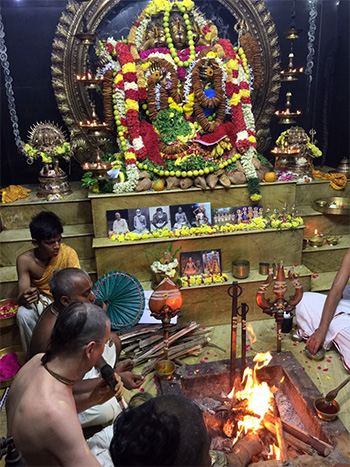Question: I was curious as to why the Ramayana seems to have been embraced culturally by much of Southeast Asia. If you look at Bali, Cambodia, etc., you see that much of their art, dance, etc., revolves around this Indian epic. How is it that the Ramayana has taken hold throughout south east Asia while other Indian traditions are not as strong. What is it in the Ramayana that speaks to such a vast range of people?
The reason why the Ramayana is present in every asian country is because the pastimes of Ramachandra took place in each of those countries in different Treta yugas. Rama’s incarnation takes place in every Treta yuga, and in each incarnation the pastimes have slight variations, including the location of Ravana’s kingdom. The most recent incarnation of Rama is recorded in the Valmiki Ramayana, in which Ravana’s kingdom was the island of Lanka.
The ancient island of Lanka actually has no connection with the present island of Ceylon. According to the Ramayana of Valmiki, Sri Lanka was located 800 miles south of the the Indian coast. If we take into account the geography mentioned in various puranas and ancient histories, we also see that the southern coast of India previously extended much further than it does at present. For example, there were three different cities that had the name Madurai in different periods. As the coast receded, each city became submerged in water, and a new “Madurai” was formed further inland. Thus, the exact location of where Sri Lanka was will be hard to ascertain, but certainly it was a distant land. That island of Lanka is no longer present, as it was submerged within the ocean.
In other Treta yugas, Ravana’s kingdom was located in other places, such as Indonesia and China. In Indonesia, Ravana’s main form was that of a bear, and in China he utilized the body of a dragon. In Valmiki Ramayana we find that Ravana had a wife from every species of life, and he assumed suitable bodies to interact with them. But his original form in this Treta yuga was human-like. In the other Treta yugas his original form was not always human-like, as was the case in China and Indonesia.
In the Puranas we also find descriptions of Rama avataras from other Treta yugas. There is even a conversation between Sita Devi and Rama, where Rama is refusing to allow Sita to enter the forest with Him. In response Sita Devi says, “If you don’t let me come, You will be the first Rama who doesn’t allow His wife to accompany Him into the forest.” There are several other places where such conversations take place.
The basic reason why the Ramayana is present in each asian country is because it is their own ancient history, whereas the Mahabharata and the Puranas are more centered on India. Even in the case of Mahabharata you find Russian tales about a man corresponding to Bhima. This is because Bhima visited Russia while collecting taxes for Yudhisthira’s sacrifice.
Receive our daily email newsletter on Hinduism, Yoga, Meditation, Ayurveda and Natural Healing.






